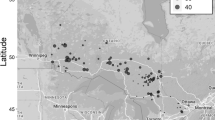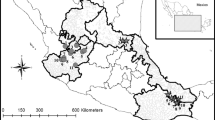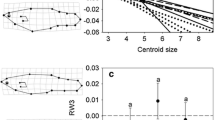Abstract
Many populations have consistently biased adult sex ratios with important demographic and evolutionary consequences. However, geographical variation, the mechanisms, temporal dynamics and predictors of biased sex ratios are notoriously difficult to explain. We studied 334 wild populations of four species of African annual fish (Nothobranchius furzeri, N. kadleci, N. orthonotus, N. rachovii) across their ranges to compare their adult sex ratio, its seasonal dynamics, interpopulation variation and environmental predictors. Nothobranchius populations comprise a single age cohort and inhabit discrete isolated pools, with wide-ranging environmental conditions (habitat size, water turbidity, structural complexity, predators), making them ideal to study adult sex ratio variation. In captivity adult sex ratios were equal. In natural populations, adult sex ratios were biased 1:2 toward females in three study species while N. kadleci had sex ratios at unity. There was a decline in the proportion of males with age in one species, but not in the other species, implying most severe male mortality early after maturation, declining later perhaps with a decrease in male abundance. In general, the populations at vegetated sites had relatively more males than populations at sites with turbid water and little vegetation. Selective avian predation on brightly coloured male fish likely contributed to female dominance and vegetation cover may have protected males from birds. In addition, an aquatic predator, a large belastomid hemipteran, decreased the proportion of males in populations, possibly due to greater male activity rather than conspicuous colouration. Alternative explanations for a sex ratio bias, stemming from male–male contests for matings, are discussed. We conclude that the effect of environmental conditions on adult sex ratio varies dramatically even in closely related and ecologically similar sympatric species. Therefore, difficulties in explaining the ecological predictors of sex ratio biases are likely due to high stochasticity rather than limited sample size.


Similar content being viewed by others
References
Arendt JD, Reznick DN, López-Sepulcre A (2014) Replicated origin of female-biased adult sex ratio in introduced populations of the Trinidadian guppy (Poecilia reticulata). Evolution 68:2343–2356
Bartáková V, Reichard M, Janko K, Polačik M, Blažek R, Reichwald K, Cellerino A, Bryja J (2013) Strong population genetic structuring in an annual fish, Nothobranchius furzeri, suggests multiple savannah refugia in southern Mozambique. BMC Evol Biol 13:196
Bartoń K (2012) MuMIn: multi-model inference. R package version 1(2). http://CRAN.R-project.org/package=MuMIn
Blažek R, Polačik M, Reichard M (2013) Rapid growth, early maturation and short generation time in African annual fishes. EvoDevo 4:24
Boukal DS, Berec L, Křivan V (2008) Does sex-selective predation stabilize or destabilize predatory-prey dynamics? PLoS ONE 3:e2687
Burnham KP, Anderson DR (2002) Model selection and multimodel inference: a practical information-theoretic approach. Springer, New York
Clutton-Brock TH, Coulson T (2002) Comparative ungulate dynamics: the devils is in the detail. Philos Trans R Soc Lond B 357:1285–1298
Clutton-Brock TH, Albon SD, Guinness FE (1989) Fitness costs of gestation and lactation in wild mammals. Nature 337:260–262
Clutton-Brock TH, Price OF, Albon SD, Jewel PA (1991) Persistent instability and population regulation in Soay sheep. J Anim Ecol 60:593–608
Clutton-Brock TH, Rose KE, Guinness FE (1997) Density–related changes in sexual selection in red deer. Proc R Soc B Biol Sci 264:1509–1516
Dorn A, Ng’oma E, Janko K, Reichwald K, Polačik M, Platzer M, Cellerino A, Reichard M (2011) Phylogeny, genetic variability and colour polymorphism of an emerging animal model: the short-lived annual Nothobranchius fishes from southern Mozambique. Mol Phylogenet Evol 61:739–749
Ewulonu UK, Haas R, Turner BJ (1985) A multiple sex chromosome system in the annual killifish, Nothobranchius guentheri. Copeia 1985:503–508
Field DL, Pickup M, Barrett SC (2012) Comparative analyses of sex-ratio variation in dioecious flowering plants. Evolution 67:661–672
Forsgren E, Amundsen T, Borg A, Bjelvenmark J (2004) Unusually dynamic sex roles in a fish. Nature 429:551–554
Genade T (2005) Laboratory manual for culturing N. furzeri. http://www.nothobranchius.info/pdfs/lab_protocols_1.pdf
Genade T, Benedetti M, Terzibasi E, Roncaglia P, Valenzano DR, Cattaneo A, Cellerino A (2005) Annual fishes of the genus Nothobranchius as a model system for aging research. Aging Cell 4:223–233
Greenwood PH (1986) The natural history of African lungfishes. J Morphol 190:163–179
Haas R (1976a) Sexual selection in Nothobranchius guentheri (Pisces: Cyprinodontidae). Evolution 30:614–622
Haas R (1976b) Behavioral biology of the annual killifish, Nothobranchius guentheri. Copeia 1976:80–91
Hamilton WD (1967) Extraordinary sex ratios. Science 156:477–488
Hardy ICW (2002) Sex ratio. Concepts and research methods. Cambridge University Press, Cambridge
Harper JM (2010) Introduction: metabolism, life history and aging. Integr Comp Biol 50:778–782
Hoelzel AR, Le Boeuf BJ, Reiter J, Campagna C (1999) Alpha-male paternity in elephant seals. Behav Ecol Sociobiol 46:298–306
Hurst GD, Jiggins FM, von der Schulenburg JHG, Bertrand D, West SA, Goriacheva II, Zakharov IA, Werren JH, Stouthamer R, Majerus MEN (1999) Male–killing Wolbachia in two species of insect. Proc R Soc B Biol Sci 266:735–740
Hutchings JA, Myers RA (1987) Escalation of an asymmetric contest: mortality resulting from mate competition in Atlantic salmon, Salmo salar. Can J Zool 65:766–768
Inglima K, Perlmutter A, Markofsky J (1981) Reversible stage-specific embryonic inhibition mediated by the presence of adults in the annual fish Nothobranchius guentheri. J Exp Zool 215:23–33
Jirotkul M (1999) Operational sex ratio influences female preference and male–male competition in guppies. Anim Behav 58:287–294
Jobling S, Nolan M, Tyler CR, Brighty G, Sumpter JP (1998) Widespread sexual disruption in wild fish. Environ Sci Technol 32:2498–2506
Jubb RA (1971) A new Nothobranchius (Pisces, Cyprinodontidae) from Southeastern Rhodesia. JAKA 8:12–19
Kosztolányi A, Barta Z, Küpper C, Székely T (2011) Persistence of an extreme male-biased adult sex ratio in a natural population of polyandrous bird. J Evol Biol 24:1842–1846
Le Boeuf BJ (1974) Male-male competition and reproductive success in elephant seals. Am Zool 14:163–176
Liao CP, Yu D, Chen YY, Reichard M, Liu HZ (2014) Reproductive behaviour of female rosy bitterling Rhodeus ocellatus in response to a female-biased operational sex ratio. Behaviour 151:755–768
Lodé T, Holveck MJ, Lesbarreres D, Pagano A (2004) Sex–biased predation by polecats influences the mating system of frogs. Proc R Soc B Biol Sci 271:399–401
Lucas-Sánchez A, Almaida-Pagán PF, Madrid JA, de Costa J, Mendiola P (2011) Age-related changes in fatty acid profile and locomotor activity rhythms in Nothobranchius korthausae. Exp Gerontol 46:970–978
Maan ME, Eshuis B, Haesler MP, Schneider MV, van Alphen JJM, Seehausen O (2008) Color polymorphism and predation in a Lake Victoria cichlid fish. Copeia 2008:621–629
McKellar AE, Turcotte MM, Hendry AP (2009) Environmental factors influencing adult sex ratio in Trinidadian guppies. Oecologia 159:735–745
Pinheiro JC, Bates DM (2000) Mixed effects models in S and S-PLUS. Springer, New York
Polačik M, Reichard M (2011) Asymmetric reproductive isolation between two sympatric annual killifish with extremely short lifespans. PLoS ONE 6:e22684
Polačik M, Donner MT, Reichard M (2011) Age structure of annual Nothobranchius fishes in Mozambique: is there a hatching synchrony? J Fish Biol 78:796–809
Polačik M, Blažek R, Řežucha R, Vrtílek M, Terzibasi-Tozzini E, Reichard M (2014a) Alternative intrapopulation life-history strategies and their trade-offs in an African annual fish. J Evol Biol 27:854–865
Polačik M, Harrod C, Blažek R, Reichard M (2014b) Trophic niche partitioning in communities of African annual fish: evidence from stable isotopes. Hydrobiologia 721:99–106
Poulin R (2007) Evolutionary ecology of parasites. Princeton University Press, Princeton
Promislow DE, Montgomerie R, Martin TE (1992) Mortality costs of sexual dimorphism in birds. Proc R Soc B Biol Sci 250:143–150
R Development Core Team (2005) R: a language and environment for statistical computing. R foundation for Statistical Computing, Vienna, Austria. http://www.R-project.org
Raja S, Suleman N, Compton SG, Moore JC (2008) The mechanism of sex ratio adjustment in a pollinating fig wasp. Proc R Soc B Biol Sci 275:1603–1610
Reale D, Bousses P, Chapuis JL (1996) Female-biased mortality induced by male sexual harassment in a feral sheep population. Can J Zool 74:1812–1818
Reichard M (2010) Nothobranchius kadleci (Cyprinodontiformes: Nothobranchiidae), a new species of annual killifish from central Mozambique. Zootaxa 60:49–60
Reichard M, Smith C, Jordan WC (2004a) Genetic evidence reveals density-dependent mediated success of alternative mating behaviours in the European bitterling (Rhodeus sericeus). Mol Ecol 13:1569–1578
Reichard M, Jurajda P, Smith C (2004b) Male-male interference competition decreases spawning rate in the European bitterling (Rhodeus sericeus). Behav Ecol Sociobiol 56:34–41
Reichard M, Polačik M, Sedláček O (2009) Distribution, colour polymorphism and habitat use of the African killifish Nothobranchius furzeri, the vertebrate with the shortest life span. J Fish Biol 74:198–212
Rodd FH, Hughes KA, Grether GF, Baril CT (2002) A possible non-sexual origin of mate preference: are male guppies mimicking fruit? Proc R Soc B Biol Sci 269:475–481
Römer U, Beisenherz W (1996) Environmental determination of sex in Apistogrammai (Cichlidae) and two other freshwater fishes (Teleostei). J Fish Biol 48:714–725
Rosenthal GG, Martinez TYF, de León FJG, Ryan MJ (2001) Shared preferences by predators and females for male ornaments in swordtails. Am Nat 158:146–154
Sedláček O, Baciaková B, Kratochvíl L (2014) Evolution of body colouration in killifishes (Cyprinodontiformes: Aplocheilidae, Nothobranchiidae, Rivulidae): Is male ornamentation constrained by intersexual genetic correlation? Zool Anz 253:207–215
Shidlovskiy KM, Watters BR, Wildekamp RH (2010) Notes on the annual killifish species Nothobranchius rachovii (Cyprinodontiformes; Nothobranchiidae) with the description of two new species. Zootaxa 2724:37–57
Székely T, Weissing FJ, Komdeur J (2014a) Adult sex ratio variation: implications for breeding systems. J Evol Biol 27:1500–1512
Székely T, Liker A, Freckleton RP, Fichtel C, Kappeler PM (2014b) Sex-biased survival predicts adult sex ratio variation in wild birds. Proc R Soc B Biol Sci 281:20140342
Terzibasi Tozzini E, Dorn A, Ng’oma E, Polačik M, Blažek R, Reichwald K, Petzold A, Watters B, Reichard M, Cellerino A (2013) Parallel evolution of senescence in annual fishes in response to extrinsic mortality. BMC Evol Biol 13:77
Tobler M, Schlupp I, Plath M (2007) Predation of a cave fish (Poecilia mexicana, Poeciliidae) by a giant water-bug (Belostoma, Belostomatidae) in a Mexican sulphur cave. Ecol Entomol 32:492–495
Tobler M, Franssen CM, Plath M (2008) Male-biased predation of a cave fish by a giant water bug. Naturwissenschaften 95:775–779
Valenzano DR, Kirschner J, Kamber RA, Zhang E, Weber D, Cellerino A, Englert C, Platzer M, Reichwald K, Brunet A (2009) Mapping loci associated with tail color and sex determination in the short-lived fish Nothobranchius furzeri. Genetics 183:1385–1395
Wehi PM, Nakagawa S, Trewick SA, Morgan-Richards M (2011) Does predation result in adult sex ratio skew in a sexually dimorphic insect genus? J Evol Biol 24:2321–2328
Wildekamp RH (2004) A world of killies: atlas of the oviparous cyprinidontiform fishes of the world, vol 4. American Killifish Association, Elyria
Wilson K, Hardy ICW (2002) Statistical analysis of sex ratios: an introduction. In: Hardy ICW (ed) Sex ratio. Concepts and research methods. Cambridge University Press, Cambridge, pp 48–92
Wourms JP (1972) The developmental biology of annual fishes III. Pre-embryonic and embryonic diapause of variable duration in the eggs of annual fishes. J Exp Zool 182:389–414
Acknowledgments
Funding came from the Czech Science Foundation (P506/11/0112). We thank Carl Smith, Rowena Spence and two anonymous referees for comments on the manuscript. All work complied with legal regulations of Mozambique (collection permit DPPM/053/7.10/08 and export permit 013/MP/2008 of the Ministry of Fisheries) and the Czech Republic (CZ62760203).
Author information
Authors and Affiliations
Corresponding author
Electronic supplementary material
Below is the link to the electronic supplementary material.


Rights and permissions
About this article
Cite this article
Reichard, M., Polačik, M., Blažek, R. et al. Female bias in the adult sex ratio of African annual fishes: interspecific differences, seasonal trends and environmental predictors. Evol Ecol 28, 1105–1120 (2014). https://doi.org/10.1007/s10682-014-9732-9
Received:
Accepted:
Published:
Issue Date:
DOI: https://doi.org/10.1007/s10682-014-9732-9




